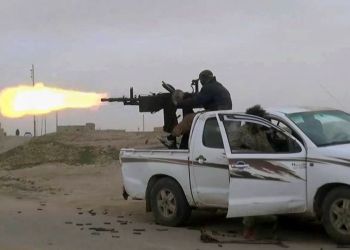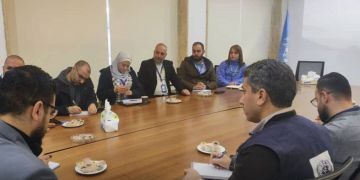This post is also available in:
![]() العربية
العربية
Russia’s priority in maintaining its position in Syria has led to its political and military dealing with Israel
On Tuesday May 6, 2020, Israeli Defense Minister Naftali Bennett announced that Israeli air strikes on Iran (al-Quds Force) would continue until the end of its presence in Syria. On the same day, a number of Israeli defense officials told Israeli media that Iran was reducing its forces and evacuating its bases in Syria.
The statements came just after an Israeli airstrike on Al-Safira Defense Research Center near Aleppo in northern Syria on May 6, 2020. In this article, we will discuss the conflicting political, military, and economic interests of Iran and Russia in Syria and Russia’s role in reducing Iran’s military presence in southern Syria.
Al-Quds Force changes its policy in Syria from countering terrorism into confronting Israel
Following the defeat of Daesh and al-Qaeda-linked terrorist groups in southern and southwestern Syria, especially in the areas adjacent to the Israel-controlled al-Golan Heights in 2017, al-Quds Force changed its military policy from fighting the terrorist groups into confronting Israel. It decided to form a new division and establish several military bases on the outskirts of Damascus and Masyaf. The focus on military conflict with Israel has led to extensive Israeli air strikes, that caused heavy losses in its ranks.
The escalation started on February 12, 2017 when al-Quds Force sent a drone over Israel to take photos and videos, but the drone was quickly shot down on al-Golan heights by an Israeli AH-64D military helicopter. Then, Eight F-16I fighters carried out massive airstrikes on targets of al-Quds Force in Syria. The airstrikes led to the killing of dozens of members from the IRGC and the Syrian and Lebanese militias, while Israel lost only one fighter.
The Israeli airstrikes continued on positions of al-Quds Force and its militias in southern Syria. Israeli fighter jets launched several airstrikes on Syria without fear of being targeted by Syrian fighter jets and defense systems. The aerial attacks peaked on May 20, 2018 during the operation “House of Cards”, in which 28 Israeli jets launched 70 cruise missiles at 7 targets belonging to al-Quds Force and the Syrian army in al-kiswah, Damascus and other areas. They crossed al-Golan Heights and killed dozens of members from the Iranian and Syrian forces.
Russia gives the green light to Israel
Since September 2015, when Russia was directly involved in the Syrian war, tens of billions of dollars have been spent to fight the terrorist groups, which led to the elimination of Daesh in many parts of Syria and the liberation of many areas from terrorist groups.
The main goal of the Russian government is to maintain security and stability in Syria and protect its permanent military presence in Latakia province to help the Russian navy dominate the eastern Mediterranean waters.
Russia’s priority in maintaining its role and position in this strategic point of the world requires it to deal with Israel politically and militarily, and not and to stop or prevent its attacks on al-Quds Force in Syria.
The change in the strategic priority of al-Quds Force’s policy, following the liberation of southern Syria in 2018, from fighting terrorism into countering Israel was in conflict with Russia’s political, military and economic interests in Syria and the eastern Mediterranean region. This change in policy was an important reason why Israel and Russia are seeking to reduce the military presence of the Islamic Republic of Iran in southern Syria.
At the invitation of Russian President Vladimir Putin, the Israeli Prime Minister and a group of politicians traveled to Moscow to see the Victory Day parade on May 10, 2018. Both sides discussed the Israeli airstrikes on al-Quds Force, which took place the following day.
The Russians coordinated with the Israeli side to avoid casualties and material damage to the Russian military forces. The Russians did not intervene to prevent a large-scale Israeli air strike during the operation “House of Cards” on May 10.
On Wednesday, July 11, 2018, the Israeli Prime Minister met again with the President of Russia in Moscow, during which he discussed the Israeli airstrikes on a Syrian ballistic missile facility and a plant in Masyaf. Once again, Russian officials gave the green light to Israel to launch an attack on Iranian positions in southern Syria, also three days later, the final assembly line of Tishrin ballistic missiles, was attacked in Masyaf with no intervention by the Russian forces which have the S-400 long-range defense system in Latakia.
Russia pressures Iran to leave southern Syria
As Russia has the S-400 and S-1 defense systems to protect Hmeimim air base and the Tartus naval base, the Syrian defense factories thought that these areas are safe so they started to produce Tishrin ballistic missiles (the Syrian name for Iran’s Fatih 110 missile) in Latakia.
Then, on September 17, 2018, the Israeli aircraft launched an airstrike on these factories.
The Air Defense Forces of the Syrian Arab Army responded by firing dozens of surface-to-air missiles to destroy cruise missiles and F-16 fighters flying over the Mediterranean Sea, but the response mistakenly led to the downing of a drone and a Russian Ilyushin Il-20M by a Syrian S-200 defense system. 17 members of the plane’s crew were killed in the incident.
This alarmed Russia, and prompted it to hand over S-300PM-2 systems to the Syrian Arab Army Air Defense Forces as a punitive action but provocative step for Israeli, that prevented it from carrying out airstrikes for several months.
The Russian officials also pressured their Iranian counterparts to avoid large military presence in southern Syria for the Russian interests in the region not to be compromised. This was the beginning of a large-scale relocation of al-Quds Force to the eastern region of Syria following the defeat of Daesh in Deir Ezzor. After that, al-Quds Force and the forces affiliated with it controlled Al-Bukamal area after defeating Daesh in the Syrian province of Deir Ezzor. They took the area as the main base for presence in Syria.
Will al-Quds Force leave Syria?
As al-Quds Force was unable to rebuild its military bases in southern Syria due to the lack of political and military support from Russia, it began establishing a military base under the name of al-Imam Ali near Al-Bukamal eastern Syria in late 2018. That was at the request of Russia to clear southern Syria from a large-scale Iranian military presence, that can launch ballistic attacks on Israel from a distance of 500 kilometers. At a cost of several hundred billion tomans, this base was established near the Iraqi-Syrian border.
On September 3, 2019, media outlets published, for the first time, satellite images of Imam Ali’s military base, which was about to be completed. Only six days later, the Israeli aircraft targeted it, killing 21 members of Iran’s Revolutionary Guard. The Israeli airstrike targeted the al-Quds Force and its proxy Iraqi militias, and destroyed large amounts of their weapons.
The Israeli Air Force used F-35I radar fighters called “Adir” for the first time in the operation. Satellite images taken about a week after the airstrike showed that Iran did not stop completing and developing this huge 20-square-kilometers base.
As the base was unable to protect itself from Israeli airstrikes, it built a network of underground tunnels to store equipment, including ballistic missiles. Satellite images showed these tunnels for the first detected in November last year, which prompted Israel to continue its airstrikes on the base.
F-35I fighters launched an air strike on the base on January 10, 2019, destroying a number of weapons and killing eight members of Hezbollah and Sayyid al-Shuhada militias. On March 12, 2019, Israel carried out similar airstrike on imam Ali base near Al-Bukamal, killing 26 members of Hashd Al-Shaabi, while it seems that al-Quds Force commanders have no intention to reduce or withdraw their forces from Syria.
The Recent Israeli air strikes on Iranian Revolutionary Guard positions in central and southern Syria, especially in Damascus, as well as the Russian government pressure on Iran, have pushed the IRGC to reduce the number of its fighters in these areas. This doesn’t mean that the IRGC has completely withdrawn from Syria, as al-Quds Force continues to rebuild the damaged parts of al-Imam Ali’s base and build new parts of it in Al-Bukamal area eastern Syria.
This means that Israeli air strikes on al-Quds Force will continue in Syria, and that the force will lose more of its fighters and its equipment. As the base is far from Latakia and the strategic areas controlled by Russia in Syria, it seems that the Russians do not have to force Iran to leave the region.
By Babak Taqvyi, an Iranian security and military expert
The article was translated from Persian
The original article is available on the link.












